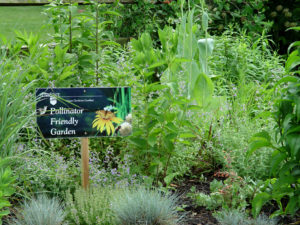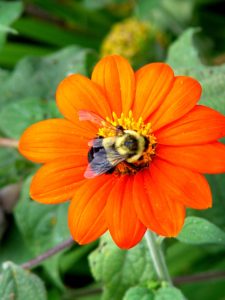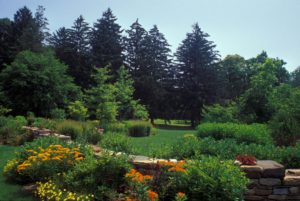Pollinators: Why It’s Not So Simple as Just Planting All Natives
June 19th, 2018
This is a piece on pollinators and plants that I wrote in 2015 for the Patriot-News. It rounds out the look we’ve been taking at the native-plant “controversy” the last two weeks.
Gardeners are getting the message that they can help birds, bees and nature in general by planting more native plants.
But that message sometimes has converted into a call to plant nothing but native plants, a version that goes something like: “Native plants are eco-friendly, pollinator-saving, and morally superior, while plants brought here since European settlement are invasive, useless to wildlife, and choices that only careless, reckless and clueless people plant.”
No wonder the whole native-vs.-non-native issue leads to peony guilt or that rare clash in the otherwise serene world of flowerdom.
Now comes a somewhat controversial new study out of plant-loving England that claims that native plants aren’t always the No. 1 choice of pollinators, that many non-native plants provide value to beneficial wildlife, and that a mix of natives and non-natives is the best way to go – especially if you plant a wide diversity of species that blooms continuously throughout the season.
“These findings will help gardeners confidently pack their borders, window boxes and (yards) with flowers without getting hung up on the idea that they are somehow doing the ‘wrong thing’ if the plants are not all U.K. natives,” concludes the report from the Royal Horticultural Society.
This same debate has boiled in the U.S. for more than a decade as the native plant movement has gained steam.
What’s fueled the issue lately is a dwindling pollinator population and what role a plant’s “nativeness” plays in pollinators’ plight.
Why should we care?
Because according to America’s own new May 2015 “National Strategy to Promote the Health of Honeybees and Other Pollinators,” three-quarters of the world’s plants need pollinator help to reproduce, and about one-third of every bite of food we take comes via the work of a pollinator, most often a bee.
Like them or not, bees are enormously important to our commercial food supply – to the tune of $15 billion a year in crop value, the U.S. Department of Agriculture says.
The bee decline is alarming enough that the U.S. government assigned a task force to come up with solutions.
Among its recommendations: stem the loss of pollinator habitats, take a new look at pesticides (especially bee-toxic ones), rethink our weed-management strategies on public land, and encourage more pollinator-friendly plantings.
It’s that last one where home gardeners come into play.
Researchers such as Dr. Douglas Tallamy, an entomology professor at the University of Delaware and author of “Bringing Nature Home” (Timber Press, $19.95, 2009), have been saying for years that the urban and suburban landscapes are the new refuge for pollinators.
Tallamy says that every little pollinator-friendly planting in every little yard can add up to a big difference.
“In the past, we’ve asked our landscapes to be pretty and that’s it,” he said in a phone interview. “Now we need them to do other things, like support the insect population, sequester carbon, manage storm water, and help pollinators. The problem is that 80 percent of the plants in our suburban landscapes are non-native, mostly from Asia.”
Tallamy advocates native plants because he says they’re much more useful as a whole than non-natives – especially native trees and shrubs, which he says are “far superior” in supporting the caterpillars that feed birds and many other wildlife species.
Of the top 50 moth- and butterfly-supporting woody plants, Tallamy’s research claims that 49 of them are U.S. natives. Of the top 50 non-woody, herbaceous species, 34 are U.S. natives.
“As a group, native plants have evolved with native pollinators,” explains Dr. Harland Patch, a research scientist in Penn State University’s Department of Entomology and a member of Penn State’s Center for Pollinator Research. “Non-natives don’t produce the same signals that are attractive to pollinators.”
But as the British study points out, that’s not to say non-natives are useless.
“Within each class, there are those that are more attractive and those that are less,” says Patch. “Some introduced plants can be wildly attractive to pollinators, especially ones that produce a lot of nectars.”
That explains why you’ll see bees, butterflies, and other insects flying around such non-natives as butterfly bush, catmint, lavender, sedum, salvia, Russian sage, mints, lantana, daisies, alyssum and zinnias.
Although pollinators prefer natives, says Tallamy, “If their mouthparts work, they don’t care if it’s native or non-native.”
Or as Tallamy also says, “It’s not as simple as plant natives and save the world.”
For one thing, it depends on what you’re trying to attract.
Some pollinators are “generalists” that will feed on a variety of nectars and pollens while others are “specialists” that need one particular species – either for feeding or for hosting their eggs.
The best known example of the latter is how monarch butterflies need the milkweeds that we’re very good at eradicating with roadside herbicides.
“There are 13 species of insects that only use goldenrod,” says Tallamy. “So if you don’t have that plant, you just lost those 13 species.”
Patch says Pennsylvania has 700 species of bees, and some are generalists and some are specialists.
Further complicating it, the same insect might have different needs at different stages.
Plus, a plant’s usefulness can vary greatly depending on whether it’s a straight, original species or a variety developed with improved traits (as most garden center plants are, including natives).
So what’s a gardener to do?
“I can’t tell you how many times people have asked me for THE LIST,” says Patch. “But the first question is going to be, ‘Which pollinator do you want to help?’”
Patch says there’s been very little research into exactly which landscape plants are most helpful to the most pollinators – something Penn State’s Center for Pollinator Research and others are working on now.
“It’s very hard to test every plant,” he says. “Hopefully, in the next few years we’ll have enough information to make recommendations. This is on a lot of people’s radars.”
Dr. Robert Berghage, an associate professor of horticulture at Penn State and another Center for Pollinator Research member, thinks it makes most sense to focus on picking plants best suited for each site rather than worrying about origin.
“Simply because a plant was in Pennsylvania before Columbus arrived doesn’t make it better or worse than one that wasn’t,” he says. “A colleague of mine at the University of Sheffield has done similar studies looking at green roofs and found that diversity is far more important than native vs. non-native status. You can argue that there is nothing natural at all about some of the artificial habitats we create in and around suburban and urban areas. So why get hung up on a plant’s origin in a unnatural environment?
“My personal preference is to select plants based on garden performance and pollinator attractiveness, which often leads to cultivars and hybrids that may or may not be native-based, depending on your definition of what is native.”
Berghage also advises against plants that are “invasive, excessively weedy or that cause other problems, whether they are native or not.”
“I’d use some non-natives, so long as they’re not invasive,” agrees Tallamy. “The goal I’d focus on more than anything in home gardens is reducing the lawn. But what do you replace it with? That’s the challenge. Does everything have to be native? No. But if you’re going to replace the lawn with 100 crape myrtles and that’s it, it’s not going to be very helpful.”
Tallamy advocates “functional diversity” and says natives, as a whole, deliver that the best.
“It’s hard to lose if you’re planting a diversity of native plants,” he says.
He also points out that continuous bloom is an important goal.
“Native bees can’t take a week off,” he says.
Patch says planting in “floral clumps” is another pollinator-friendly move. That means rather than plant just one of a lot of different plants, it’s better to plant five or more of the most attractive plants that bloom over a wide period of time.
Just about everyone agrees that knocking off spraying – or at least being more judicious about it – is another pollinator-friendly step.
As for how many non-natives are “OK” in a pollinator-friendly garden, the U.S. Natural Resources Conservation Service is one of the few resources to put any specifics to it. It advises a mix that’s at least 75 percent native.
Tallamy offers no hard-and-fast number but says, “We do live in these landscapes, so it’s important to pay attention to our needs, too. But in the past, that’s been 100 percent. We’ve treated plants just as decoration.”
With the loss of habitat and the widespread spraying on farmland and roadsides, our choices at home will be more important than ever for a healthy ecology, he says.
Adds Patch: “The recommendation I’d give to people who are interested in pollinator attraction and pollinator support is to plant a diversity of mostly native plants along with some well chosen non-natives.
“What we really need to do is change our perception of a landscape, to think of it as something dynamic that attracts birds and butterflies and pollinators and that’s not just something to look it.”











